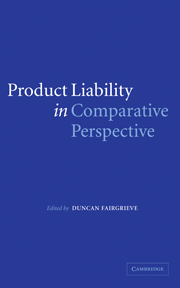Book contents
- Frontmatter
- Contents
- List of figures
- Foreword by Sir Michael Burton
- List of contributors
- Preface
- 1 Introduction
- PART I Country reports
- 2 The use of comparative law in A & Others v National Blood Authority
- 3 Spanish product liability today – adapting to the ‘new’ rules
- 4 Interaction between the European Directive on Product Liability and the former liability regime in Italy
- 5 L'Exception française? The French law of product liability
- 6 German product liability law: between European Directives, American Restatements and common sense
- 7 Dutch case law on the EU Product Liability Directive
- 8 Defect in English law – lessons for the harmonisation of European product liability
- PART II European influences
- PART III Comparing systems
- Appendix
- Index
6 - German product liability law: between European Directives, American Restatements and common sense
from PART I - Country reports
Published online by Cambridge University Press: 28 July 2009
- Frontmatter
- Contents
- List of figures
- Foreword by Sir Michael Burton
- List of contributors
- Preface
- 1 Introduction
- PART I Country reports
- 2 The use of comparative law in A & Others v National Blood Authority
- 3 Spanish product liability today – adapting to the ‘new’ rules
- 4 Interaction between the European Directive on Product Liability and the former liability regime in Italy
- 5 L'Exception française? The French law of product liability
- 6 German product liability law: between European Directives, American Restatements and common sense
- 7 Dutch case law on the EU Product Liability Directive
- 8 Defect in English law – lessons for the harmonisation of European product liability
- PART II European influences
- PART III Comparing systems
- Appendix
- Index
Summary
Introduction
Product liability has today in Germany established itself as a separate niche of tort law that is of particular relevance for consumers and business. In both doctrine and practice it is a field that is inextricably linked to global developments. The fundamental change in case law in 1968 which practically focussed the issue of negligence liability on the question of defect was no doubt influenced by the developments in the United States surrounding Henningsen v Bloomfield Motors Inc., Greenman v Yuba Powers and the adoption of §402A of the Restatement of Torts Second (1965). With the implementation of the European Directive on Product Liability in 1990, a second pillar of liability was added to the existing system. The question since then is whether and to what extent the Directive has made an impact. The current product liability debate in the Unites States is particularly helpful in this context, for the Third Restatement of Torts: Products Liability (1998) describes the situation under negligence law quite accurately, while the Directive at first sight shows more similarity to Section 402A of the Restatement Second of Torts. This is not to say that product liability is an American or European import. That a producer is liable if it fails to adopt a reasonable alternative design was decided by the Stuttgart Court of Appeal in 1907, and the Reichsgericht found in the Brunnensalz case of 1915 that proof of a manufacturing defect was sufficient to establish a prima facie case of negligence.
- Type
- Chapter
- Information
- Product Liability in Comparative Perspective , pp. 100 - 125Publisher: Cambridge University PressPrint publication year: 2005
- 5
- Cited by

